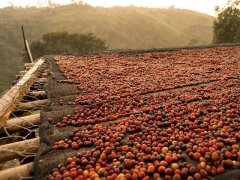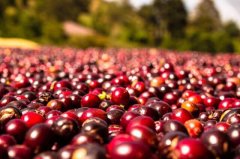Sidamo 90 + Dre Ella (Flower language) Coffee beans treated with honey introduce flavor description
Ethiopian coffee is known as "wilderness coffee", and a cup of Ethiopian coffee can bring you a primitive experience you've never had before. Ethiopia has unique natural conditions suitable for growing all imaginable varieties of coffee.
According to the above four different modes of production, Ethiopian coffee can be divided into nine major coffee producing areas, including five boutique coffee areas: Sidamo, Yegashefi, Harald, Lim and Lekampu. and four general commercial bean producing areas: Gemma, Irugbo, Tibby and Bekaa. The sun or water washing methods are used in each district, and different treatment methods also affect the flavor. At present, the sun method accounts for about 80%, and washing accounts for about ⒛%. Sidamo and Yejia Xuefei are mainly washed by water, supplemented by the sun, while Lim and Tiebi producing areas are mainly washed by water. Sun-dried beans are mainly Harald, Gemma, Lekampudi and Yilu Gbagbo.
The Sidamo producing area, which is 1400-2200 meters above sea level, is a famous boutique coffee area in southern Ethiopia, bordering Kenya. The washed Sidamo is light green, the beans are small, the growth oval, the fruit is full, the average quality is good, the smell is fragrant and mellow, the coffee raw beans are slightly gray, some places are thick and some are small, the acidity is soft and strong, and the mellowness is suitable. Sweet and spicy, it is one of the courtyard coffee in the highlands of southern Ethiopia.
Unlike ordinary African coffee, Sidamo has clear acidity, smooth taste and delicate floral smell. The taste is unique and mellow, the taste is chic and pleasing, and the slowly rising end rhyme contains chic sweetness. A drop of entrance, endless aftertaste, with wild beauty, is considered to be a thorny rose in coffee.
It is an internationally renowned coffee bean production and sales company, and is famous for providing rare and unique raw coffee beans. JosephBrodsky was officially founded in 2007 and began the next year. Since now, we can see the traces of winning awards in coffee competitions, large and small, all over the world.
Coffee is classified according to the intensity of fruit flavor, which is different from the traditional classification of Washed, Honey and Natural. It also has three categories: W2, H2 and N2, but different treatments create different levels of fruit flavor, so you may drink sun-treated or water-washed coffee beans in the classification of honey flavor "H2".
It is not difficult to find that usually beans have the letters N, H or W, such as EthiopianYiagacheffeG3N, which is commonly seen in the market, where N stands for Natural. H=Honey (honey treatment) and W=Washed (water washing). Here, 90 + also has a different view, they think that rather than using the method of treatment to distinguish beans, it should be distinguished by the trend of flavor. Generally speaking, each kind of treated beans will have a more representative flavor.
However, 90+ believes that sometimes there will be the same flavor trend under different treatments, for example, the flavor performance of beans in honey may be similar to that of washed beans, so their family has introduced three basic flavor labels of N2, H2 and W2, and the flavor is distinguished by the intensity of fruit aroma and taste:
Low fruit tonality with emphasis on brightness, acidity and floral aroma
Moderate fruit tonality, emphasizing sweetness, fruit taste (non-aroma) and tea taste
Strong fruit tonality, emphasizing unrestrained flavor, sweet and sour, jam and dried fruit
Is a sub-brand of 90+Ninetyplus, retains the amazing flavor of 90 +, but the price is more approachable. DerarEla means HighlyFloral in Sidamo, that is, "fragrant flowers".
Flavor description:
Rich aromas of berries, walnuts, flowers, cream, peaches, apples, grapes and a variety of tropical fruits.
Product name: Ethiopia 90+levelupDerarEla Dre Ella (fancy language)
Baking degree: light baking is recommended
Grade: excellent
Particles: full
Acidity: slight acid
Equilibrium: very stable
Flavor: very unique, delicate and rich taste, with rich aromas of fruit and berries, flowers, grapes and a variety of tropical fruits
Coffee producing areas: Sidamo Province, Ethiopia
Raw bean treatment: sun exposure
Important Notice :
前街咖啡 FrontStreet Coffee has moved to new addredd:
FrontStreet Coffee Address: 315,Donghua East Road,GuangZhou
Tel:020 38364473
- Prev

2016 Nicaragua excellent Cup COE Champion-Orange Fruit Manor Honey treatment Elephant Bean Coffee Flavor characteristics
Professional barista exchange please follow the coffee workshop (Wechat official account cafe_style) Product name: 2016 Nicaragua (COE) champion orange fruit manor elephant bean honey treatment (non-bidding batch) (Nicaragua Finca El Naranjo Dipilto Maragogype Honey/Full Miel) flavor description: dry fragrance: flower sweet, black sugar sweet, honey, pepper, vanilla
- Next

World's Top Coffee beans: introduction to the Flavor and taste of Kenya AA Coffee Variety
AA (KenyaNgariamaAA), Kenya: the indispensable coffee in the world's recognized and most advanced Arabica coffee series is Kenya AA. The AA here refers to raw beans.
Related
- Detailed explanation of Jadeite planting Land in Panamanian Jadeite Manor introduction to the grading system of Jadeite competitive bidding, Red bid, Green bid and Rose Summer
- Story of Coffee planting in Brenka region of Costa Rica Stonehenge Manor anaerobic heavy honey treatment of flavor mouth
- What's on the barrel of Blue Mountain Coffee beans?
- Can American coffee also pull flowers? How to use hot American style to pull out a good-looking pattern?
- Can you make a cold extract with coffee beans? What is the right proportion for cold-extracted coffee formula?
- Indonesian PWN Gold Mandrine Coffee Origin Features Flavor How to Chong? Mandolin coffee is American.
- A brief introduction to the flavor characteristics of Brazilian yellow bourbon coffee beans
- What is the effect of different water quality on the flavor of cold-extracted coffee? What kind of water is best for brewing coffee?
- Why do you think of Rose Summer whenever you mention Panamanian coffee?
- Introduction to the characteristics of authentic blue mountain coffee bean producing areas? What is the CIB Coffee Authority in Jamaica?

